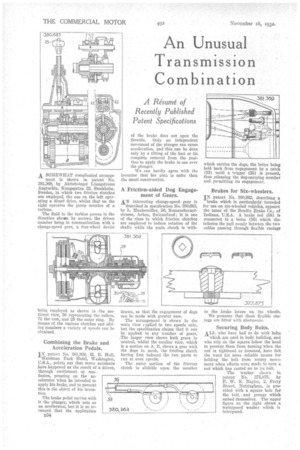An Unusual Transmission Combination
Page 80

If you've noticed an error in this article please click here to report it so we can fix it.
A Résumé of Recently Published Patent Specifications
A. SOMEWHAT complicated arrange
ment is shown in patent No. 381,368, by Aktiebolaget tjungstroms Angturbin, Kungsgatan 32, Stockholm, Sweden, in which two friction clutches are employed, the one on the left operating a direct drive, whilst that on the right operates the pump member of a turbine.
The fluid in the turbine passes in the direction •shown by arrows, the driven member being in communication with a change-speed gear, a free-wheel deviee
being employed as shown in the sectional view, 30 representing the rollers, 71 the cam, and 29 the outer ring. By means of the various clutches and sliding members a variety of speeds can be obtained.
Combining the Brake and Acceleration Pedals.
IN patent No. 381,369, II. E. Hull, Wardnaan Park Hotel, Washington, U.S.A., points out that many accidents have happened as the result of a driver, through excitement or con fusion, pressing on the accelerator when he intended to apply his brake, and to prevent this is the obiect of his invention.
The brake pedal carries with it the plunger, which acts as an accelerator, but it is so arranged that the applieation B54 of the brake does not open the throttle. Only an independent movement of the plunger can cause acceleration, and this can be done only by a tilting of the foot or its complete removal from the position to apply the brake to one over the plueger.
We can hardly agree with the inventor that his plaa is safer than the usual construction.
A Friction-aided Dog Engagement of Gears.
AN interesting change-speed gear is
described in specification No. 380,683, by L. Hunkemoller, 50, Romanshornerstrasse, Arbon, Switzerland; it is one of the class in which friction clutches Are employed to induce rotation of the shafts while the main clutch is with
drawn, so that the engagement of dogs can be made with greater ease.
The arrangement is shown in the main view r pplied to two speeds only, but the specification claims that it can be applied to any number of gears. The larger view shows both gears in neutral, whilst the smaller view, which is a section on A, B, shows a gear with the dogs in mesh, the friction clutch having first induced the two parts to run at even speeds.
The outer portion of the friction clutch is slidable upon the member which carries the dogs, the latter being . held back from engagement by a catch (22) until a trigger (25) is pressed* thus releasing the dog-carrying member and permitting its engagement.
Brakes for Six-wheelers.
IN patent No. 880,262, describing a
brake which is particularly intended for use on six-wheeled vehicles, appears the name of the Bendix Brake Co., cl Indiana, U.S.A. A brake rod (58) is connected to a beam (56) which distributes the pull evenly between the two cables passing through flexible casings to the brake levers on the wheels. We presume that these flexible casings are fitted with abutments.
Securing Body Bolts. ALL who have bad to do with bolts which are used in body building, and who rely on the square below the head to prevent them from turning when the nut is tightened or loosened, have felt the want for some reliable means for holding the bolt from rotary movement when efforts were made to turn a nut which has rusted on to its bolt. The washer shown in Patent No. 375,875, by P. W. S. Naylor, 2, Ferry Street, Nottingham, is provided with a' square hole for the bolt, and prongs which embed themselves. The upper figure on the right shows a waterproof washer which is
interposed. ,




















































































































